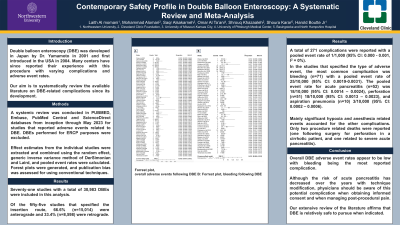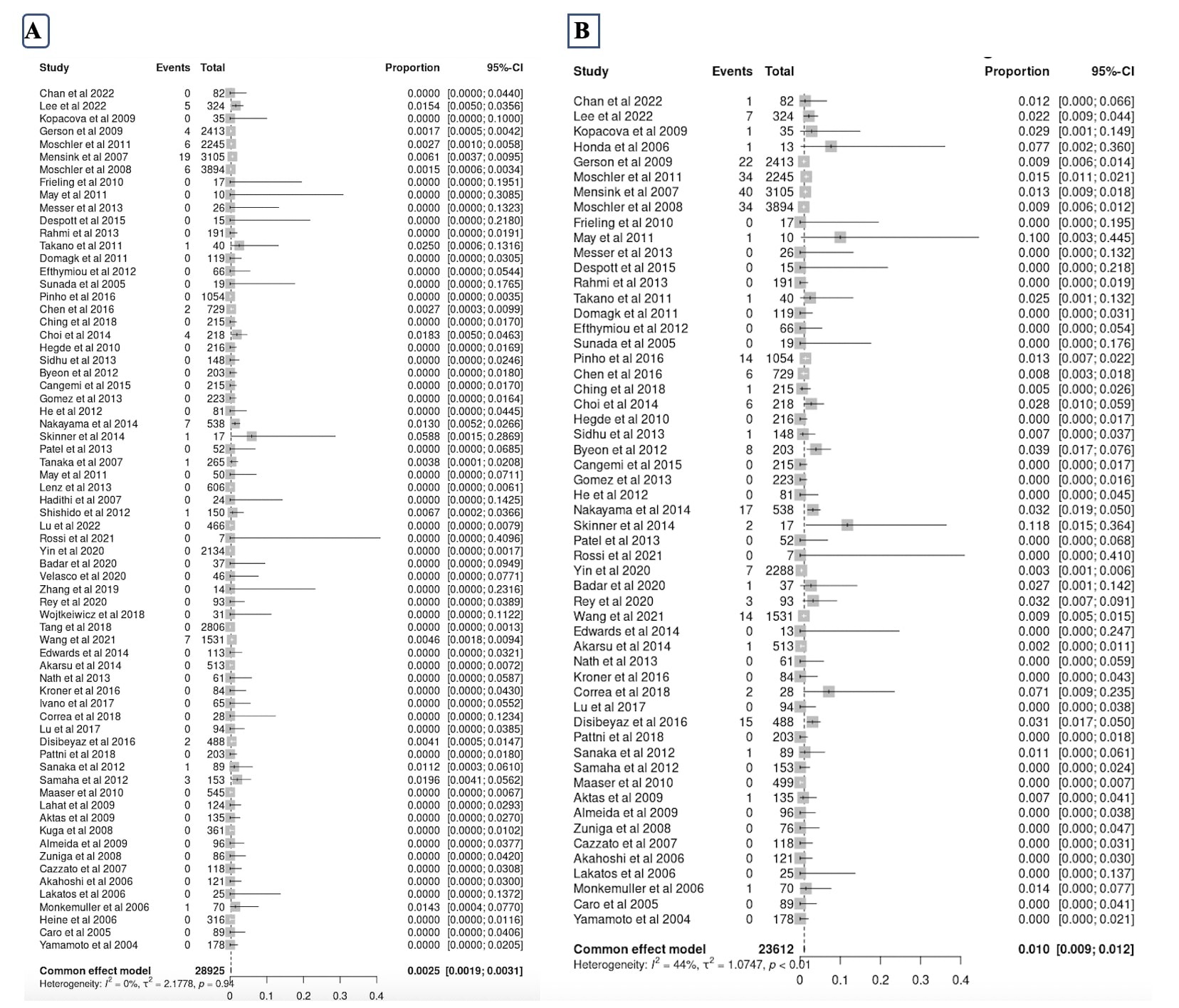Monday Poster Session
Category: Small Intestine
P2635 - Contemporary Safety Profile in Double Balloon Enteroscopy: A Systematic Review and Meta-Analysis
Monday, October 23, 2023
10:30 AM - 4:15 PM PT
Location: Exhibit Hall

Has Audio
- LA
Laith Al-momani, MD
Northwestern University
Chicago, Illinois
Presenting Author(s)
Laith Al Momani, MD1, Mohammad Alomari, MD2, Saqr Alsakarneh, MD3, Omar Al Ta’ani, MD4, Shrouq Khazaaleh, MD5, Shoura Karar, MD6, Harold Boutte Jr., MD7
1Northwestern University, Chicago, IL; 2Cleveland Clinic, Weston, FL; 3University of Missouri-Kansas City, Kansas City, MO; 4Allegheny General Hospital, Pittsburgh, PA; 5Cleveland Clinic, Cleveland, OH; 6Basingstoke and North Hampshire Hospital, Basingstok, England, United Kingdom; 7Northwestern University Feinberg School of Medicine, Chicago, IL
Introduction: Double balloon enteroscopy (DBE) was developed in Japan by Dr. Yamamoto in 2001 and first introduced in the USA in 2004. Many centers have since reported their experience with this procedure with varying complications and adverse event rates. Our aim is to systematically review the available literature on DBE-related complications since its development.
Methods: A systemic review was conducted in PUBMED, Embase, PubMed Central and ScienceDirect databases from inception through May 2023 for studies that reported adverse events related to DBE. DBEs performed for ERCP purposes were excluded. Effect estimates from the individual studies were extracted and combined using the random effect, generic inverse variance method of DerSimonian and Laird, and pooled event rates were calculated. Forest plots were generated, and publication bias was assessed for using conventional techniques.
Results: Seventy-one studies with a total of 30,983 DBEs were included in this analysis. Of the fifty-five studies that specified the insertion route, 66.6% (n=15,014) were anterograde and 33.4% (n=8,598) were retrograde. A total of 271 complications were reported with a pooled event rate of 1/1,000 (95% CI: 0.000 - 0.001, I2 = 0%). In the studies that specified the type of adverse event, the most common complication was bleeding (n=71) with a pooled event rate of 25/10,000 (95% CI: 0.0019-0.0031). The pooled event rate for acute pancreatitis (n=52) was 18/10,000 (95% CI: 0.0014 – 0.0024), perforation (n=51) 18/10,000 (95% CI: 0.0013 – 0.0023), and aspiration pneumonia (n=10) 3/10,000 (95% CI: 0.0002 – 0.0006). Mainly significant hypoxia and anesthesia related events accounted for the other complications. Only two procedure related deaths were reported (one following surgery for perforation in a cirrhotic patient, and one related to severe acute pancreatitis).
Discussion: Overall DBE adverse event rates appear to be low with bleeding being the most reported complication. Although the risk of acute pancreatitis has decreased over the years with technique modification, physicians should be aware of this potential complication when obtaining informed consent and when managing post-procedural pain. Our extensive review of the literature affirms that DBE is relatively safe to pursue when indicated.

Disclosures:
Laith Al Momani, MD1, Mohammad Alomari, MD2, Saqr Alsakarneh, MD3, Omar Al Ta’ani, MD4, Shrouq Khazaaleh, MD5, Shoura Karar, MD6, Harold Boutte Jr., MD7. P2635 - Contemporary Safety Profile in Double Balloon Enteroscopy: A Systematic Review and Meta-Analysis, ACG 2023 Annual Scientific Meeting Abstracts. Vancouver, BC, Canada: American College of Gastroenterology.
1Northwestern University, Chicago, IL; 2Cleveland Clinic, Weston, FL; 3University of Missouri-Kansas City, Kansas City, MO; 4Allegheny General Hospital, Pittsburgh, PA; 5Cleveland Clinic, Cleveland, OH; 6Basingstoke and North Hampshire Hospital, Basingstok, England, United Kingdom; 7Northwestern University Feinberg School of Medicine, Chicago, IL
Introduction: Double balloon enteroscopy (DBE) was developed in Japan by Dr. Yamamoto in 2001 and first introduced in the USA in 2004. Many centers have since reported their experience with this procedure with varying complications and adverse event rates. Our aim is to systematically review the available literature on DBE-related complications since its development.
Methods: A systemic review was conducted in PUBMED, Embase, PubMed Central and ScienceDirect databases from inception through May 2023 for studies that reported adverse events related to DBE. DBEs performed for ERCP purposes were excluded. Effect estimates from the individual studies were extracted and combined using the random effect, generic inverse variance method of DerSimonian and Laird, and pooled event rates were calculated. Forest plots were generated, and publication bias was assessed for using conventional techniques.
Results: Seventy-one studies with a total of 30,983 DBEs were included in this analysis. Of the fifty-five studies that specified the insertion route, 66.6% (n=15,014) were anterograde and 33.4% (n=8,598) were retrograde. A total of 271 complications were reported with a pooled event rate of 1/1,000 (95% CI: 0.000 - 0.001, I2 = 0%). In the studies that specified the type of adverse event, the most common complication was bleeding (n=71) with a pooled event rate of 25/10,000 (95% CI: 0.0019-0.0031). The pooled event rate for acute pancreatitis (n=52) was 18/10,000 (95% CI: 0.0014 – 0.0024), perforation (n=51) 18/10,000 (95% CI: 0.0013 – 0.0023), and aspiration pneumonia (n=10) 3/10,000 (95% CI: 0.0002 – 0.0006). Mainly significant hypoxia and anesthesia related events accounted for the other complications. Only two procedure related deaths were reported (one following surgery for perforation in a cirrhotic patient, and one related to severe acute pancreatitis).
Discussion: Overall DBE adverse event rates appear to be low with bleeding being the most reported complication. Although the risk of acute pancreatitis has decreased over the years with technique modification, physicians should be aware of this potential complication when obtaining informed consent and when managing post-procedural pain. Our extensive review of the literature affirms that DBE is relatively safe to pursue when indicated.

Figure: A: Forrest plot, overall adverse events following DBE
B: Forrest plot, bleeding following DBE
B: Forrest plot, bleeding following DBE
Disclosures:
Laith Al Momani indicated no relevant financial relationships.
Mohammad Alomari indicated no relevant financial relationships.
Saqr Alsakarneh indicated no relevant financial relationships.
Omar Al Ta’ani indicated no relevant financial relationships.
Shrouq Khazaaleh indicated no relevant financial relationships.
Shoura Karar indicated no relevant financial relationships.
Harold Boutte Jr. indicated no relevant financial relationships.
Laith Al Momani, MD1, Mohammad Alomari, MD2, Saqr Alsakarneh, MD3, Omar Al Ta’ani, MD4, Shrouq Khazaaleh, MD5, Shoura Karar, MD6, Harold Boutte Jr., MD7. P2635 - Contemporary Safety Profile in Double Balloon Enteroscopy: A Systematic Review and Meta-Analysis, ACG 2023 Annual Scientific Meeting Abstracts. Vancouver, BC, Canada: American College of Gastroenterology.
